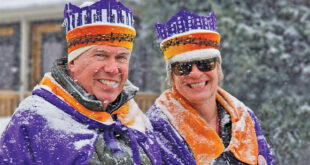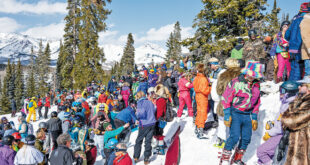To the Editor:
The Forest Service and BLM have released the Gunnison Basin Federal Lands Travel Management Draft Environmental Impact Statement (DEIS) and comments are due by June 3, 2009.
CBMBA encourages the bicycling communities of Crested Butte, Gunnison and the world to submit constructive comments on this plan. We would love to say this is an easy process—it is not. The USFS/BLM is asking for insightful comments on routes for their three draft alternatives. Many of you want us to say “choose this one” and we wish it was that easy. If we could only pick one, we have to go with Alternative #4.
The Crested Butte Mountain Bike Association (CBMBA) supports Alternative # 4, the recreationally intensive alternative as presented by the USFS/BLM. Alternative # 4 has the best mix of new trails and existing trails maintaining a designation that includes bicycling. This alternative would require the least changes of all the Alternatives. This alternative also allows the Forest Service to maintain their goal of an overall net loss in routes, both road and trail.
Unfortunately Alternative #4 is portrayed as the motorized alternative but bicycling is heavily favored in this alternative also. CBMBA specifically asked the USFS to not lump bicyclists in with motorized users in a meeting with land managers in the summer of 2007. IMBA (International Mountain Bike Association) also asked the GMUG to categorize mountain bicyclists as non-motorized users at that same time. As evident in Alternative #4 that’s where cycling ended up. This is not what CBMBA asked for. This confuses other non-motorized groups into thinking Alternative #4 is not a green choice. CBMBA worked towards a non-motorized recreational alternative, which would have been a blend of Alternatives #3 and #4, but this is not the case with this DEIS.
Alternative #4 is the alternative where CBMBA and Gunnison Trails’ new non-motorized trails are included. Some users might be in favor of the new non-motorized trail proposals and keeping a majority of trails open to mountain bikes but they cannot endorse the motorized components of Alternative #4.
These contradictions point out the importance of users commenting trail by trail instead of just choosing one Alternative.
Alternative #3 has many trail closures for bicycling. It doesn’t increase cycling opportunities, it decreases them. The mission statement of CBMBA is to promote cycling opportunities in the Gunnison Valley. The closures are being driven by directives which CBMBA believes fall into the three categories listed below.
Natural Resource Impacts of Mountain Biking
Mountain bicycling and motorized travel are inherently different. As the USFS/BLM know, bicycling is a quiet, human-powered, non-motorized method of travel. Mountain biking speeds on narrow trails will usually range between 5 and 15 miles per hour: similar to trail runners and much slower than OHVs (Off –Highway-Vehicles).
Moreover, scientific research has shown the impacts of bicycles are similar to hiking and far less than horses and OHVs. A recently completed study by Dr. Jeffrey Marion at the National Park Service’s Big South Fork National River and Recreation Area investigated impacts to a large random sample of trails, including hiking, biking, horse, OHV, and mixed-use trails.
Dr. Marion measured trail impacts across a variety of matrices and his data shows that bicycle trails have the least erosion, least amount of muddiness, and are the narrowest. (Marion, 2006) These conclusions mirror the results of previous studies. (Sprung, 2004) If there is reason for restricting only bicycles among non-motorized uses to designated routes, it cannot be based upon their environmental impacts and the best available science.
Mechanzed
CBMBA objects to the term “mechanized” when describing bicycles because this definition is unclear. The Forest Service’s definition of “mechanical transport” in the Code of Federal Regulations refers to “any contrivance… propelled by a non-living power source.”(36CFR-293.6a). By including mountain bikes in the category of mechanized travel, travel management is needlessly complicated, which unfairly and incorrectly implies mountain biking is similar to motorized travel and separate from other non-motorized uses. It is Not!
Bicycling is a quiet, human-powered, low-impact recreation, just like hiking or horseback riding. Bicyclists desire narrow trails free from the distractions and safety concerns associated with motorized travel. There is no official agency “hierarchy” of recreation that places bicycling in a separate category. It is a subjective local choice by the land managers of the GMUG and should be changed unless the agencies can provide evidence of increased impacts as compared to other non-motorized activities. CBMBA asked the BLM and Forest Service to use only two categories of transportation, motorized and non-motorized, in its planning documents. However, they chose not to. Many national forests and BLM lands use this strategy and it places mountain bicycles with forms of recreation that have similar impacts on the land and other users.
In all cases, bicycles should be referred to as non-motorized or simply as bicycles.
Recommended Wilderness and the Draft GMUG Plan
CBMBA is concerned that the draft maps appear to ban bicycling in potential Recommended Wilderness areas in Alternatives #2 and #3. It is inappropriate to close all trails to bicycling in areas that have been proposed in the defunct draft Grand Mesa, Uncompahgre and Gunnison (GMUG) plan as Recommended Wilderness. Not only has a federal judge declared the draft plan illegal, but the public has not yet had an official opportunity to comment on the proposed Recommended Wilderness boundaries. These areas are not Recommended Wilderness and may never become so. To close them to bicycles prematurely is an exercise of improper, heavy-handed management. When a Wilderness Area is actually approved by Congress, CBMBA would absolutely reconsider its position on this issue. Until then please keep all trails open in these areas.
CBMBA wishes to specifically mention again the proposal for a singletrack corridor between Gunnison and Crested Butte. The only logical route runs through a “possible” Recommended Wilderness area on the west and north sides of Whetstone Mountain. The travel planning process should not reject Gunnison Trails’ proposal because of its potential conflict with a “possible” Recommended Wilderness area. The Green Lake, Carbon Creek, Wildcat and Para Mi Trails are also in this area. It would be inconsistent with policies of the current GMUG forest plan, and out of line with the vast majority of National Forests in Regions 1, 2, 4, 5, 8, 9 and 10 that allow bicycling in Recommended Wilderness.
The Crested Butte Mountain Bike Association welcomes all interested trail users to come discuss these issues at our final Travel Management Talk following our Trail Day this Thursday, May 28 between 6 and 9 p.m.—at the Brick Oven. The beers are on us!
CBMBA’s first Trail Day of the season is this Thursday Afternoon May 28 at 4 p.m. We will meet at the Four-way Stop behind the Chamber of Commerce building. We will be working on two projects, the Snodgrass Trail on the Washington Gulch side and the Canal Trail in the Brush Creek Area.
Don’t forget cbmba.org for the current trail report and Work Day info!
Crested Butte Mountain Bike Association
 The Crested Butte News Serving the Gunnison Valley since 1999
The Crested Butte News Serving the Gunnison Valley since 1999



